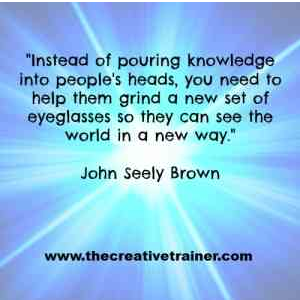Not long ago I wrote about a recurring theme we were seeing among our clients and blog comments: With all the changes in the business environment, who is going to be our customer in five years? Now the question is even more urgent: What about right now?
As a corporate anthropologist we continue to see possibilities that our clients don’t seem to want to see. Is that you, as well? Here are 5 ways that you can overcome the resistance your brain has to see things in new ways, to fight change and deny those possibilitie
Maybe New Customers Are All Around You?
Might this be the perfect time to learn how to use corporate anthropology to ignite change in your organization? As John Seely Brown (Chief of Confusion, USC visiting scholar and the independent co-chairman of the Deloitte Center for the Edge) famously said: “The way forward is often all around you.” The challenge is to get people to see what is happening with fresh eyes. Here is his other well-known quote:
So how can companies determine whom they will (hopefully) be selling to in the next year, much less the next five years? How will they find them? How will they have to change in order to attract them? And, how can they begin to penetrate that future market with the right sales strategies, product lines and service solutions? As one CEO recently said to me, “It was easier to shrink my firm than to figure out how to grow it now.”
5 ways to anticipate and attract your future customer today
Now is the time to get your organization mobilized and exploring future possibilities before someone else captures the market before you. To help get you started, here are 5 things to think about that can jump start your new business strategic planning as you tackle how to reignite growth in your business—right now!
1. Demography is Destiny
I always like to begin here. If you haven’t noticed, people under 40 today (Millennials) have grown up digital. They also represent almost 50% of the work force. We need to pay attention to them.

What does that mean for you? Well, if you’re in real estate, it means a great deal. Millennials are postponing marriage and children, and are renting, often in urban areas, rather than buying in the suburbs like their parents. Not business as usual for realtors, forcing them to adjust to these hanging times. I gave a presentation on this very topic to the Real Estate Alliance in 2015. I invite you to watch it here:
For those in the oil and gas industry, ask yourselves, what are people searching for? How could your patents and solutions be applicable? Buyers are purchasing in new ways. Can you adapt and capitalize on their unmet needs?
2. Speed to Market
In one of my workshops, a CEO told a story about a prospective client who wanted his company to build a building, but faster. At SAMC, we have had several clients whose customers also wanted them to build faster, deliver a product faster or design a new solution faster. At a recent workshop, the same theme emerged. How fast can you get me the specs?
Increasingly, speed to market is becoming an infuential theme. What is interesting is that this CEO realized that his employees did not think they could build faster, but a competitor did. The competing company took on the job and delivered the desired results—and yes it was really faster. Is speed a competitive advantage that might bring in customers you have been pushing away? Are these your future customers—ones who want things “faster”? Check out this terrific article from Entrepreneur about three companies that are using speed as a competitive edge.
3. Who Aren’t You Focused On?
A company in the office security business was frustrated by the competition in his market space—companies which were basically doing the same job the same way and for about the same pricing. When we were working with one of the staff members, he described companies they weren’t doing work for: healthcare facilities, urgent care centers, mobile restaurants, day care centers and others who could use their approach to security solutions. When we asked him why he had chosen the company’s current market segment, he said that he really hadn’t. It had chosen him, without much strategy attached. Maybe it was time for him, and you to turn the tide and go after key markets rather than simply hope the phone rings with business.
How? One of the best ways is to spend a day listening to your customer service people answer incoming calls. Who are they saying “No, we don’t do that” to…and why aren’t you doing that? In my new book, “On the Brink: A Fresh Lens to Take Your Business to New Heights,“ I have a story I share about Jim Riley and what he learned about unmet needs by listening to the incoming calls. His company, Laclede Chain, grew 40% by doing things people were asking for that previously it “didn’t do.”
4. Incremental Change Might Not Be Enough
Virtually every one of our clients or CEOs whom we’ve met with have spoken about how innovative their companies were. When pressed further, however, it was hard for them to tell us exactly what they had done that was really innovative. A lot of their innovations were merely incremental improvements, many of which added costs along with more features—and possibly more benefits. The question we raised was whether value creation was enough to find that next customer segment that might not be using them today. If their products or services were that good, why weren’t they dominating their markets? Instead of “talking” innovation, start doing. Here’s a start: Value Innovation.
5. Who is Searching For Your Solutions Today
At SAMC, we repeatedly find that quite often, companies are discounting customer emails and inquiries—the “What If’s” that inquirers are asking for that sales people ignore. One story I like to share is about an individual in a workshop who realized that the customer he was selling his patented foam insulation to kept asking about other products that he needed, “what if’s.” Yet, the salesman and the sales manager kept ignoring him. That was where all the opportunity was, sitting there, awaiting their innovation.
And don’t forget about the Internet. Future customers are calling, searching, emailing constantly…and yet all too often, people discount those inquiries or forget about them while they focus on today’s tasks. We had one customer who grew his company by 40% after sitting on his phones and listening to what people were asking for. He decided he could indeed provide it and was wondering why he had never done so in the past.
Want to learn more? Check out these blogs on the subject.
As a corporate anthropologist, I always pay attention to blogs and discussions that focus on how anthropological methods and tools are being applied in complex organizations. I’ve compiled five particularly strong posts into one informative blog which I’d like to share here:
Additional articles you might find of interest:
Also, here are three very insightful articles on preparing for tomorrow’s customer today:
- Five Ways to Prepare Today for Tomorrow’s Customer
- 4 Marketing Strategies to Influence Tomorrow’s Customer
- Who are tomorrow’s customers and how will I serve them?
As always, you can find more information on our Simon Associates website.
Also, let us know how we might be of help. Perhaps a little anthropology could help your business grow? Contact us at your convenience.
Want to know more?
Want to dig deeper and lose those anchors holding you back? This might be a good time to get a copy of my new book, “On the Brink: A Fresh Lens to Take Your Business to New Heights.” In it, I share with you seven stories of companies, perhaps like yours, that were “on the brink,” yet ready to soar. They just needed to step out and see what was all around them. There are lots of insights to share and an anthropology tool kit that might be of help to you as you embark on your own growth journey.
From Observation to Innovation
Andi Simon
Corporate Anthropologist | President and CEO
Simon Associates Management Consultants
@simonandi
www.andisimon.com





